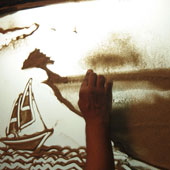The term Experimental Animation is usually applied to animation that is somewhat away from mainstream studio animation and often uses different materials and techniques. It may be interpreted in several ways.
Amongst those who popularised experimental animation and showed how animation could be done differently are Norman McLaren, Caroline Leaf, Len Lye, Alexander Alexeiff, Peter Foldes, Jan Svankmajer, Paul Driessen, amongst many others. Norman McLaren who was called as the ‘poet of animation’ spent a lifetime experimenting with sound, music and motion. He painted directly on film and showed how animation could be done without a camera. He also painted sound and produced some amazing soundtracks that no human or object had created.
Norman McLaren's critically acclaimed film Neighbours that also won an Oscar in 1952 used pixilation, demonstrating how technique and content are inseparable. Caroline Leaf’s The Owl Who Married a Goose is a beautiful tale told with sand. The Street which was nominated for an Academy Award is made with paint on glass. Alexander Alexieff and Claire Parker together invented the pin-screen that allowed them to create images like engravings by pushing pins on a board.
The audience of animation is no longer limited to children alone. That too is a result of constant experimentation with the form and function of animation.
Today we see examples of animation where the maker and their material are seen together. Animators are not hiding behind their images; they are also a part of the image, as performers. What appears to fascinate animators is the process and its demystification. So not only do we see the animation in our mind’s eye, we also see the process by which it comes about.
Besides materials, processes and narrative structures what is also being explored is how animation is projected. Projections are made on buildings, on performers and on shop windows. Muto, a wall painted animation by Blu (blublu.org) is an animation on a life-size scale. The animation becomes a seamless part of everyday life.
In this course, we will explore experimental animation in three broad areas:
• Process
• Material
• Narrative Structure


